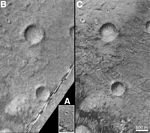Airy-0 is a crater inside the larger Airy Crater on Mars, whose location historically defined the Martian prime meridian. It is about 0.5 km (0.3 mile) across and lies within the dark region Sinus Meridiani, one of the early albedo features to be identified on Mars. In 2018, the IAU Working Group on Cartographic Coordinates and Rotational Elements recommended setting the longitude of the Viking 1 lander (47.95137° west) as the reference line.[a] This definition maintains the position of the center of Airy-0 at 0° longitude, within the tolerance of current cartographic uncertainties.[1]
Airy-0 Crater from MRO; also, from A to C, Mariner 9, Viking 1 and Mars Global Surveyor (Airy-0 is the larger crater in top center of each frame). | |
| Planet | Mars |
|---|---|
| Region | Inside Airy Crater |
| Coordinates | 5°06′S 0°00′E / 5.1°S 0°E |
| Quadrangle | Sinus Sabaeus |
| Diameter | 0.5 kilometres (0.31 mi) |
| Eponym | Sir George Biddell Airy |
Merton Davies tied this crater into an extensive geodetic control network of the planet Mars based on Mariner 9 and earlier photographs.[2][3] The Mariner 9 Geodesy/Cartography Group proposed that the prime meridian of Mars be defined by the center of Airy-0, which was selected by Harold Masursky, Gerard de Vaucouleurs, and Merton Davies at a Group meeting on 14 August 1972.[4]
It was named in honor of the British Astronomer Royal Sir George Biddell Airy (1801–1892), who in 1850 built the transit circle telescope at Greenwich. The location of that telescope was subsequently chosen to define the location of Earth's prime meridian.

Notes
editReferences
edit- ^ Archinal, B.A.; Acton, C.H.; A'Hearn, M.F.; Conrad, A.; et al. (2018), "Report of the IAU Working Group on Cartographic Coordinates and Rotational Elements: 2015", Celestial Mechanics and Dynamical Astronomy, 130 (22): 22, Bibcode:2018CeMDA.130...22A, doi:10.1007/s10569-017-9805-5, S2CID 189844155,
The origin of the longitude system for Mars is now defined by assigning a longitude of 47.95137° west to the Viking 1 lander.... The longitude uncertainty within which landed resources can be determined by radiometric tracking is now ... significantly smaller than the uncertainty of determining the center of the ~500 m diameter Airy-0, the time has come to transition the orientation of the longitude system from being based on Airy-0 to the much smaller Viking 1 lander, for which there are extensive radiometric tracking data.
- ^ "The Martian Prime Meridian -- Longitude "Zero"" (MGS MOC Release No. MOC2-273). Malin Space Science Systems. 31 January 2001. Retrieved 31 March 2018.
- ^ Morton, Oliver (2002). Mapping Mars: Science, Imagination, and the Birth of a World. New York: Picador USA. pp. 22–23. ISBN 0-312-24551-3.
- ^ de Vaucouleurs, Gerard; Davies, Merton E.; Sturms, Francis M. Jr. (1973), "Mariner 9 Areographic Coordinate System", Journal of Geophysical Research, 78 (20): 4395–4404, Bibcode:1973JGR....78.4395D, doi:10.1029/JB078i020p04395
External links
edit- View of Airy-0 at Google Mars
- T. C. Duxbury; P. Christensen; D. E. Smith; G. A. Neumann; R. L. Kirk; M. A. Caplinger; A. A. Albee; N. V. Seregina; G. Neukum; B. A. Archinal (December 2014). "The location of Airy-0, the Mars prime meridian reference, from stereo photogrammetric processing of THEMIS IR imaging and digital elevation data". Journal of Geophysical Research: Planets. 119 (12): 2471–2486. Bibcode:2014JGRE..119.2471D. doi:10.1002/2014JE004678. S2CID 44052047.

